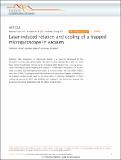Files in this item
Laser-induced rotation and cooling of a trapped microgyroscope in vacuum
Item metadata
| dc.contributor.author | Arita, Yoshihiko | |
| dc.contributor.author | Mazilu, Michael | |
| dc.contributor.author | Dholakia, Kishan | |
| dc.date.accessioned | 2013-08-29T10:31:03Z | |
| dc.date.available | 2013-08-29T10:31:03Z | |
| dc.date.issued | 2013-08-28 | |
| dc.identifier | 67273114 | |
| dc.identifier | 5f3a2913-fb40-40a0-be1b-0fdfaf05e82f | |
| dc.identifier | 84883362002 | |
| dc.identifier.citation | Arita , Y , Mazilu , M & Dholakia , K 2013 , ' Laser-induced rotation and cooling of a trapped microgyroscope in vacuum ' , Nature Communications , vol. 4 , 2374 . https://doi.org/10.1038/ncomms3374 | en |
| dc.identifier.issn | 2041-1723 | |
| dc.identifier.uri | https://hdl.handle.net/10023/4019 | |
| dc.description | This work was supported by the UK Engineering and Physical Sciences Research Council (EPSRC grant numbers: EP/J01771X/1 and EP/G061688/1) | en |
| dc.description.abstract | Quantum state preparation of mesoscopic objects is a powerful playground for the elucidation of many physical principles. The field of cavity optomechanics aims to create these states through laser cooling and by minimizing state decoherence. Here we demonstrate simultaneous optical trapping and rotation of a birefringent microparticle in vacuum using a circularly polarized trapping laser beam—a microgyroscope. We show stable rotation rates up to 5 MHz. Coupling between the rotational and translational degrees of freedom of the trapped microgyroscope leads to the observation of positional stabilization in effect cooling the particle to 40 K. We attribute this cooling to the interaction between the gyroscopic directional stabilization and the optical trapping field. | |
| dc.format.extent | 1077436 | |
| dc.language.iso | eng | |
| dc.relation.ispartof | Nature Communications | en |
| dc.rights | This work is licensed under a Creative Commons Attribution 3.0 Unported License. To view a copy of this license, visit http://creativecommons.org/licenses/by/3.0/ | en |
| dc.subject | Optical physics | en |
| dc.subject | QC Physics | en |
| dc.subject.lcc | QC | en |
| dc.title | Laser-induced rotation and cooling of a trapped microgyroscope in vacuum | en |
| dc.type | Journal article | en |
| dc.contributor.sponsor | EPSRC | en |
| dc.contributor.sponsor | EPSRC | en |
| dc.contributor.institution | University of St Andrews.School of Physics and Astronomy | en |
| dc.contributor.institution | University of St Andrews.Biomedical Sciences Research Complex | en |
| dc.identifier.doi | 10.1038/ncomms3374 | |
| dc.description.status | Peer reviewed | en |
| dc.identifier.grantnumber | EP/J01771X/1 | en |
| dc.identifier.grantnumber | EP/G061688/1 | en |
This item appears in the following Collection(s)
Items in the St Andrews Research Repository are protected by copyright, with all rights reserved, unless otherwise indicated.

